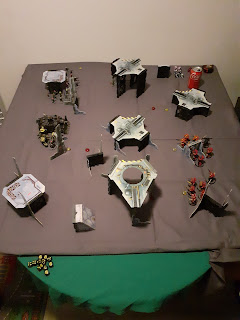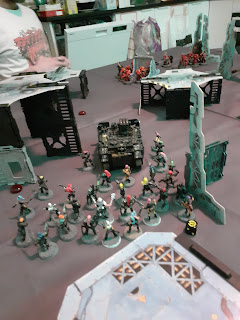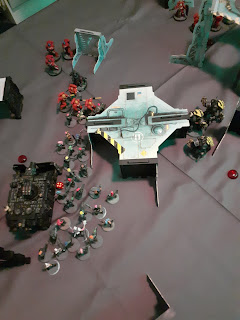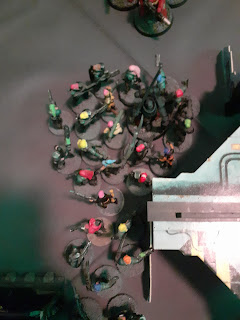Of the coming of these monstrosities and evil Forces, no man could say much with verity; for the evil of it began before the Histories of the Great Redoubt were shaped; aye, even before the sun had lost all power to light; though, it must not be a thing of certainty, that even at this far time the invisible, black heavens held no warmth for this world; but of this I have no room to tell; and must pass on to that of which I have a more certain knowledge.
- William Hope Hodgson, The Night Land
It's now time to play some 9th edition Warhammer 40,000! We're trying the Filthy Casual rules for a slightly more accessible attempt at 9th, which, frankly, seems a little difficult to wrap my mind around. Here's what I'm bringing to the table.
**
I enjoyed playing Chaos in Gladius so much that I also wanted to make some models based on it. I started with the Chaos Lord from Blackstone Fortress. The Lord is my favorite unit in the game; there's nothing like them walking up to literally anything and smashing it to pieces with their thunder hammer - and if you're very lucky, immediately turning into a Chaos Spawn afterward. I gave them a Statuesque Miniatures head, and I think it worked beautifully.
Which does remind me that I need to make a Chaos Spawn model. Proxy Studios later changed the Gladius rules so that Chaos characters don't get turned into Spawn any more, because they're cowards.
**
My Chaos Cultists were instrumental in my first 8th edition victory. They got shot to pieces, would have run away if not for my Dark Apostle, and then outflanked the enemy with Tide of Traitors. The models are quite dear to me as they were a very succesful Escher gang in our long Necromunda campaign back in the day. Obviously I wanted more cultists, and Brother Vinni had some models that suited the aesthetic exactly. I got Anna the Bonecrusher to be our cultist leader, and Veronika Zemanova because, well, I had to.
I thought the Necromunda Ambots looked really cool, and someone on reddit suggested fielding them as Mutilators in 40k. I took a stab at converting one, with a Chaos Marine head and one of those spiky things from the Chaos Terminator sprue. I think it worked out all right:
So I made two more, with CSM bits and a Statuesque roider head.
And here they are in my Word Bearers colors:
So how could I not try them?
**
Last year, I was lucky enough to get to teach a course on Trumpism at the Espoo adult education center. Taking Richard Hofstadter's Paranoid Style in American Politics as my guide, I talked about colonial and early USian anti-Catholic propaganda like the Awful Disclosures of Maria Monk, a direct predecessor of the satanic panic of the 1980s and its latter-day reincarnation as QAnon. A prominent anti-Catholic publication of the tine was the splendidly named American Protestant Vindicator, which led directly to the firm conviction that my Word Bearers absolutely need a Vindicator. Well, here it is!
This is my first shot at the black-and-silver Daedric look that I used for my Renegade Armigers on a vehicle, and I think it worked out pretty nicely.
**
So here's my 500 point Word Bearers army:
HQ - Chaos Lord - 80 pts
Plasma pistol [5], thunder hammer [20] = 105 points
Troops - 29 Chaos Cultists - 145 pts
13 × autogun (0), 13 × autopistol & ccw (0), cultist champion w/autopistol & ccw, 2 × flamer [10] = 155 points [260]
Elites - 3 Mutilators - 105 points [365]
Heavy Support - Vindicator - 130 pts
Havoc launcher [5] = 135 points [500]
I will be facing Shaun's Blood Angels:
HQ - Primaris Lieutenant - 80 points
Troops - Assault Intercessor Squad (5) - 100 points [180]
Troops - Assault Intercessor Squad (5) - 100 points [280]
Elites - Judiciar - 85 points [365]
Heavy Support - Eradicator Squad (3) - 135 points [500]
**
We set up some of my fairly ancient Necromunda terrain and rolled up a mission, ending up with Encircle.
I got the first turn, and my plan was simple: charge.
My Vindicator's shooting did absolutely nothing to anyone, and return fire from the Eradicators knocked it down to four wounds remaining. The Mutilators advanced on the objective on the right, and my Chaos Lord and Cultists charged the Intercessor squad in the center. The Judiciar used his special ability to make my Lord fight last, and he took several wounds – and then wiped out the Intercessors with his thunder hammer.
Meanwhile, the Mutilators were having a bad time: they failed their charge and the Eradicators knocked one of them out. The remaining Intercessor squad charged them, but the Lieutenant failed his charge roll.
In the central mêlée, the Judiciar charged both the Chaos Lord and the Cultists, the latter of which would have made for some hilarious overwatch if it was available. He killed my Lord, but was in turn swamped by the Cultists. The Judiciar promptly failed all his armor saves and was killed!
The Cultists consolidated into the Eradicators at the cost of a few casualties, the Intercessors finished off the last Mutilator, and the heavily damaged Vindicator continued to hang onto the objective.
At this point, I had a decent victory point lead, and elected to use my stratagem, Tide of Traitors, to regroup my cultists so they could hold the objective on my left.
With the cultists out of the way, the Vindicator opened up on the Eradicators, killing two of them! In retaliation, the Eradicator sergeant blew up the Vindicator with his melta rifle.
The Primaris Lieutenant made a heroic charge into the cultist mass and killed five of them, but to no avail.
The game was over: although the entire Chaos army except for the indomitable cultists was wiped out, I won the game with 25 VPs to 15.
This was a tremendously entertaining game, with lots of dramatic moments. I had a great time.
**
What did I learn? For starters, to not rely on my Vindicator's shooting ever getting anything done! Heavy D6 is so swingy, because a couple of bad rolls on the number of shots means nothing happens. I love how the model looked on the tabletop, but I feel like those points could have been better used.
Mutilators are garbage. They're excruciatingly slow, yet when they do get into combat, they're not that great at it either. I rolled poorly for their AP every time, so they barely made a dent in the Intercessors, but it's not like they have the attacks to seriously threaten lighter-armored units either. I don't really get what they're for. I was also a little surprised by how fragile the Chaos Lord was.
The star of the whole show was obviously my venerable Escher gang. Maybe it was the familiar surroundings, but for whatever reason, they really excelled. My opponent and I agreed that the shocking death of the Judiciar was a turning point: after that, the cultists and Eradicators tarpitted each other, letting the Vindicator clock up more victory points, and the remaining Intercessors couldn't close the gap. I'm obviously delighted by how well the cultists did, and I'm definitely keeping them as the core of my army.
As a general note, I like the Filthy Casual rules, because I think the complexity of 40k is getting a bit much. Even without stratagems, secondaries and so on, it was challenging enough to keep track of all the various auras, special rules, doctrines, chapter tactics and what have you - and all this despite the fact that my army is still basically an 8th edition one. I'm looking forward to a new CSM codex, as I think the army needs it badly, but at the same time I dread how many different sets of special faction rules it's going to have in it! I think the game is already too complicated for its own good, and looks to be getting worse.
Still, this was fun, and we're definitely playing more. I'm already thinking about my next 500-point army list...



















